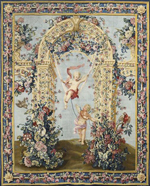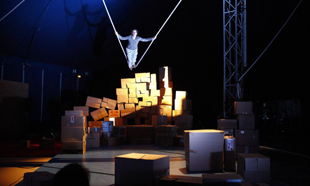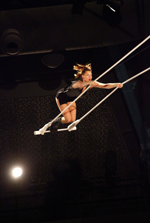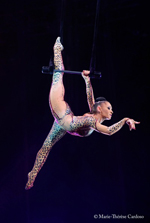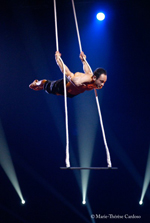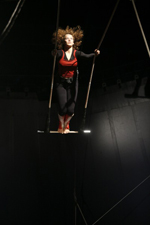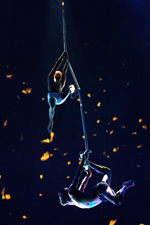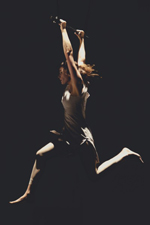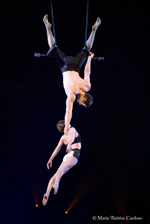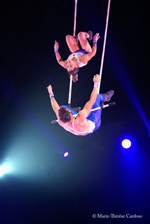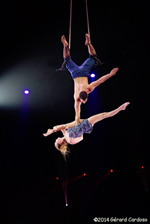From cloud swing to trapeze
by Pascal Jacob
The cloud swing is practised on a rope hung between two wooden intersections, sometimes with a very limited tension that heightens the emphasis of the central curve, and is a primary device for the development of figures that lie somewhere between balancing and swinging.
This supple rope, attached to two points set relatively high up, is considered then to be "flying." It curves under the weight of the body and is considered to be the intuitive matrix of a protean apparatus. The trapeze, from the Greek, trapezion, meaning "small table," finds a part of its history here. The rope, a simple woven form whose natural flexibility suggests the sweeping and mastered movement of a swing, is both an autonomous apparatus and the first step in a decisive transformation. The addition of a wooden bar, eventually suspended between two ropes, enabled several techniques to be developed, all arising from the same apparatus. The fixed trapeze, swinging trapeze, flying trapeze, and Washington trapeze are all, apart from a few slight differences, variants nourished by the same influence. They have not however, absorbed the cloud swing, a discipline in its own right, taught in higher education schools dedicated to the circus arts and a device enabling both numerous contemporary variations and classical sequences. These are demonstrated by the work of Dewert, an acrobat of Czech origin, the Pyongyang acrobatic company performance in 2003 at the Montecarlo International Circus Festival, or, closer to home, by Fanny Austry, Sandrine Duquesne and Marie Jolet or Julien Cramillet, all trained at the National centre for circus arts in Châlons-en-Champagne.
The fixed and swinging trapeze
by Magali Sizorn
The trapeze, a wooden or iron bar suspended between two ropes, is the circus apparatus par excellence. Its history blends with that of creating a show from gymnastics, and its multiple uses call on every scenario imaginable, from ascent to fall.
A simple object for sophisticated uses
According to Georges Strehly (1903), the "trapeze" label was linked to the original form of the apparatus, as the two ropes were not vertical, but oblique, suspended from a hook that enabled twisting and swinging movements. In the 19th century, this apparatus was borrowed by acrobats, notably Phokhion Clias, but the circus trapeze was first and foremost imported from the Amorosian gymnastic rooms in particular. Colonel Francisco Amoros had in fact designed exercises for the trapeze, among other apparatus, for his utilitarian and moral gymnastic practice.
When trapeze acts began to appear in eh circus in 1850 (the first ones are generally attributed to the Italian Francesco brothers), a race for the spectacular and feats began. Trapeze artists even flew under hot air balloons from the mid-nineteenth century onwards, or under helicopters a century later, when André Jan flew over summer places (Jan, 1953). Show logic would gradually distinguish the aims of circus and gymnastic practices.
The simplicity of the object contrasts with its sophisticated uses in a show, which sees more complex figures, work at a great height, and a combination of trapeze techniques (fixed, swinging, flying or balance), as well as combinations of performers and apparatus (two on a trapeze with a pusher and a flyer; on a double trapeze with side-by-side bars; a combination of ropes, rings, silks etc.).
A contradictory experience
In The Wings of Desire by Wim Wenders (1987), a trapeze artist pushes an angel into becoming a mortal in order to experience love. The contrasts staged and acted out in the film (life/death, materiality/immateriality, earthly/ethereal), recall the fundamental ambiguity of the trapeze artist's experience in its entirety. Thus did the Spanish Miss Mara rise above circus cupolas from the 1940s to the 1970s, in an act that combined grace, strength and risk. Suspended by the arch of her foot, she pulled herself up, then performed a swinging fall before recovering by her heels, provoking fear and relief among audiences.
The trapeze is the point of convergence for contrasts: in common practice, and in the reception of its acts, it systematically engages in a game of duality that opposes heavy and light, mobile and still, pleasure and pain, active and passive, powerful and weak, masculine and feminine. Today, Aurelia Cats' contortion act on the fixed and swinging trapeze (rewarded notably at the Festival mondial du cirque de demain in 1995) plays on these contrasts. She is both feminine and powerful; light on the apparatus, she nevertheless talks of how trapeze work marks the body. Before her, in the 1930s, Albert Powel, star of the Ringling Bros and Barnum and Bailey circus, also combined contortion and acrobatics on the trapeze, in work "remarkable … for its audacity and grace, an extremely short piece of work of rare dynamic intensity" (Medrano magazine, 1934) Wrapping himself around the trapeze bar, he is seen smiling in photographs from the era, swinging in a seemingly natural movement, making all physical effort and work disappear.
Forgetting the apparatus; exploring the void
The development and perfecting of lunge work in the 1980s under the impetus of Russian Victor Fomine and Canadian André Simard considerably changed trapeze work, which became more acrobatic, of course, but which also entered other domains than that of technical feats. Knowing that he is safe, the acrobat can more readily allow himself a work of performance. The lunge, like the aesthetic use of magnesium powder, or resin used to avoid slipping, reminds us that the trapeze artist is human, and that his primary concern is, first and foremost, not to fall. Questions of risk, performance and authenticity are no longer relevant. Verticality is a sensation, and vertigo is experienced, by the artist as well as by the audience – in a different way and position, at ground level and as though at the edge of a steep drop-off.



